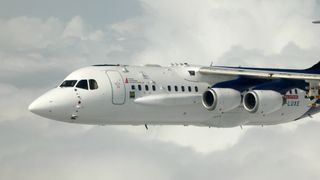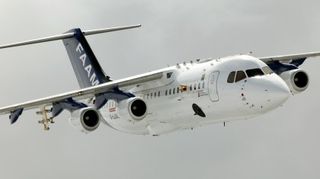The aircraft studying the climate of the future
Antiquated by aircraft standards, but inside it is anything but

The BAe 146 Atmospheric Research Aircraft (ARA) is a rather unique hunk of metal. From afar it looks rather antiquated by aircraft standards, but inside it is anything but.
The aircraft is being used to study weather patterns, climate change and global warming and will help scientists improve predictions of future Arctic climate.
The aim of the mission is to reduce the quite significant uncertainty in the representation of Arctic climate data, especially furthering the understanding of cloud and aerosol processes in climate models in general and in the Arctic in particular.

Unlike a normal passenger aircraft with its rows of airline seats, the BAe 146 ARA is fitted out with 15 mission equipment racks and scientific consoles containing computers and measuring equipment. Normally the plane of this size would carry around 100 passengers, but the normal complement on the BAe 146 ARA is up to 18 scientists. The aircraft flies some 500 science hours a year, the highest of any atmospheric research aircraft in the world.
The aircraft features a large pod on the front port side housing instruments and a range of sensors while there are pipes along the fuselage and wing-mounted pylons which can carry different instruments depending on the mission.
Preparing for flight
Over 30 engineers based in Prestwick, Scotland, played a key role in preparing this unique aircraft for its three-week tour. During the campaign the BAe 146 ARA will fly above, in, and below cloud taking measurements of cloud microphysical properties and dropping dropsondes over the open ocean, the ice edge, the marginal ice zone and solid ice.
The aircraft departed last month from its home base at Cranfield, Bedfordshire, for its tour of duty based at Kiruna in northern Sweden. From there, for its scientific research sorties, it will fly the 2.5 hour leg to Longyearbyen Airport on the Norwegian island of Svalbard. Svalbard is within the Arctic Circle and is the northernmost airport in the world that receives scheduled airline services.
Are you a pro? Subscribe to our newsletter
Sign up to the TechRadar Pro newsletter to get all the top news, opinion, features and guidance your business needs to succeed!
After refuelling, the BAe 146 ARA will fly its missions from Svalbard before returning again for more fuel and then heading back to Kiruna. A combined total of 70 hours of scientific, test and transit flying was planned for the aircraft, which originally entered service in 2004.
The plane originally made its first flight in September 1981. Five years later its fuselage was lengthened before it became a test plane for BAe. The aircraft replaced a Lockheed Hercules W2 turboprop which had been used by the Met Office from 1973 until 2001.
Dan (Twitter, Google+) is TechRadar's Former Deputy Editor and is now in charge at our sister site T3.com. Covering all things computing, internet and mobile he's a seasoned regular at major tech shows such as CES, IFA and Mobile World Congress. Dan has also been a tech expert for many outlets including BBC Radio 4, 5Live and the World Service, The Sun and ITV News.
Most Popular

